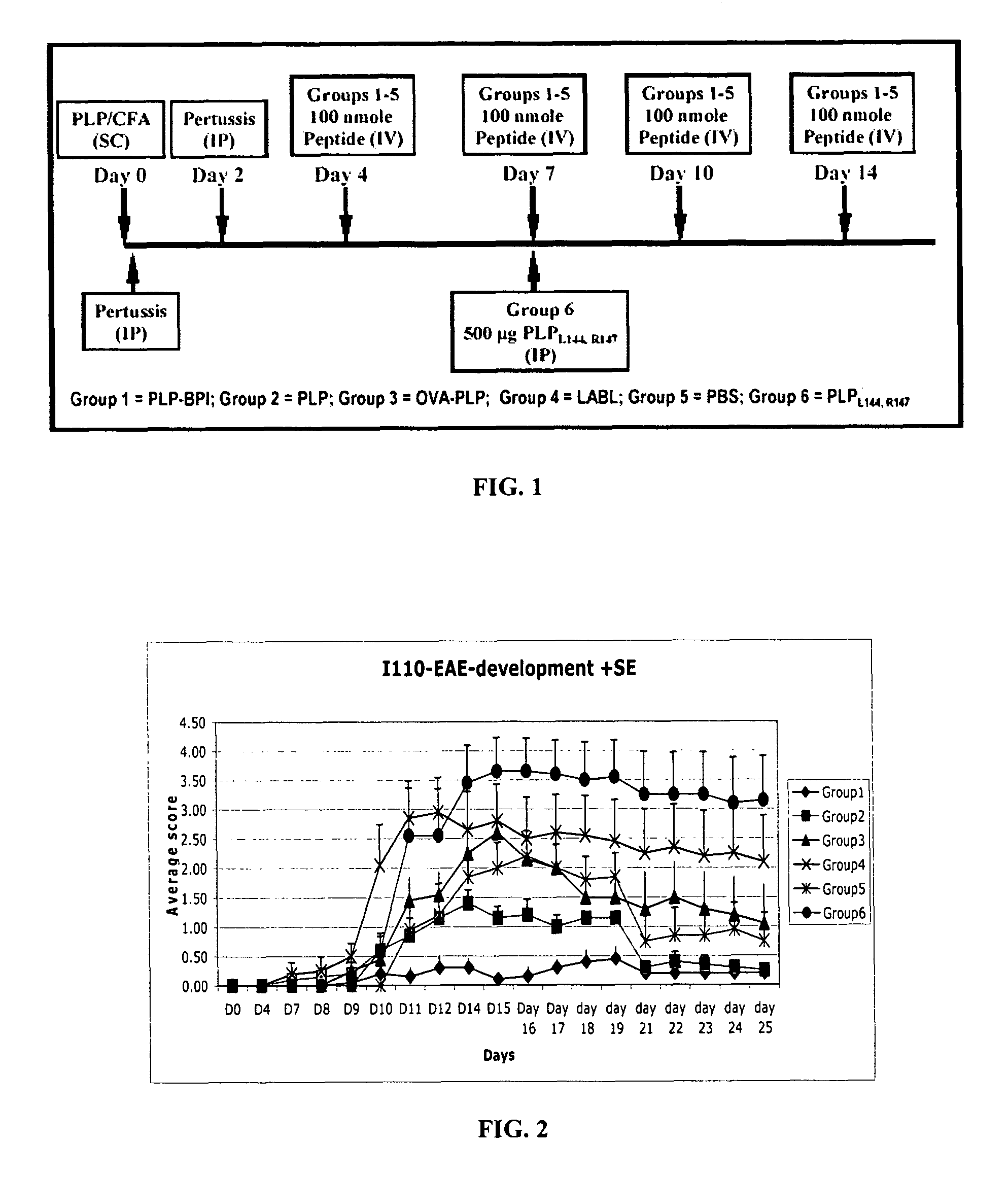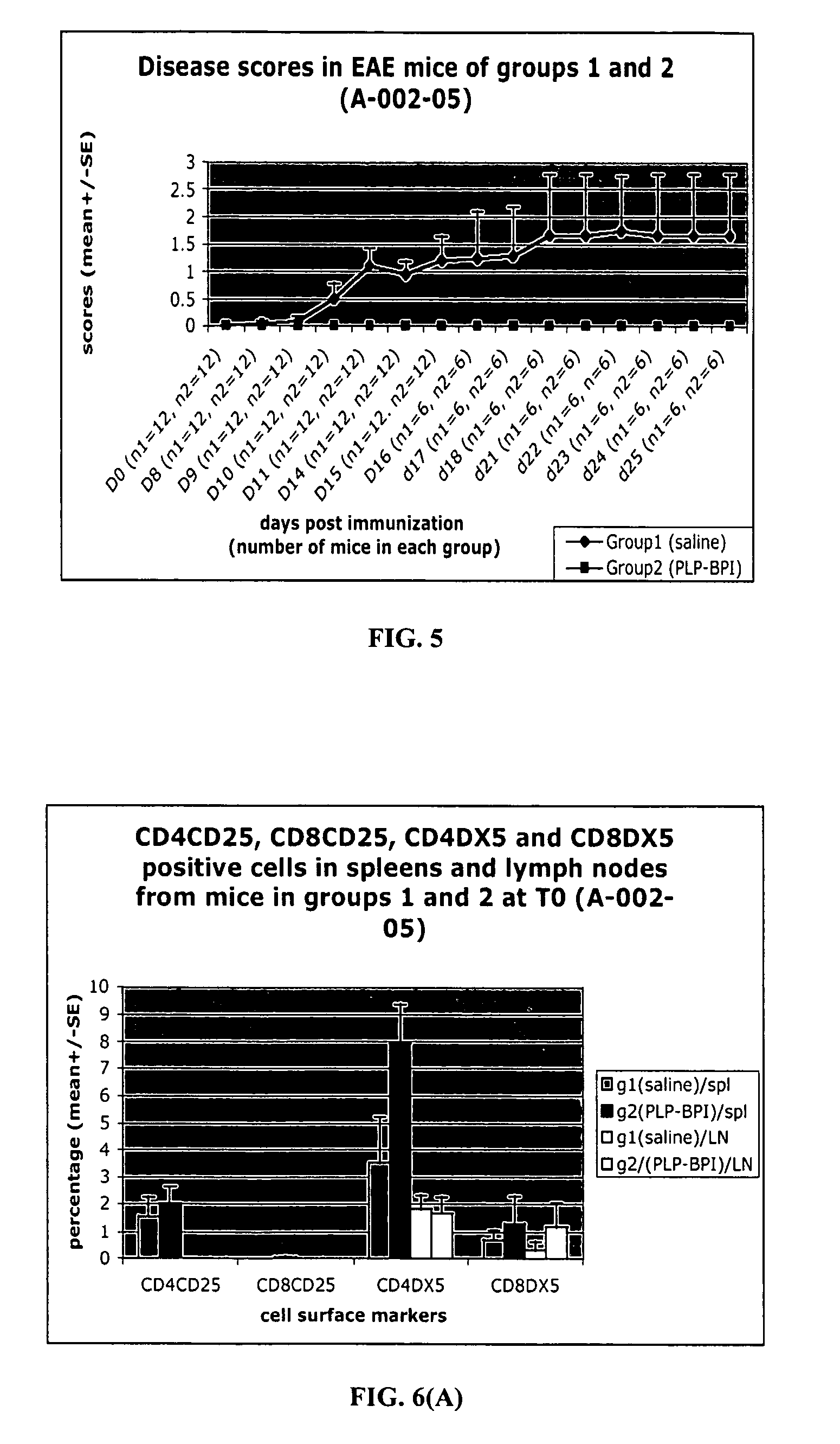Bi-functional peptides for multiple sclerosis treatment and diagnosis
a multi-functional, peptide technology, applied in the direction of peptide/protein ingredients, peptide sources, therapies, etc., can solve the problems of mri results only being used to determine the occurrence of ms, the nerve cannot conduct the electrical impulses that are needed for the nervous system to function, and the diagnosis of ms is difficult, so as to reduce the th1 immune response, and reduce the effect of th1 immune respons
- Summary
- Abstract
- Description
- Claims
- Application Information
AI Technical Summary
Benefits of technology
Problems solved by technology
Method used
Image
Examples
example 1
Synthesis of PLP-BPI
[0096]In this example, an exemplary PLP-BPI having the sequence HSLGKWLGHPDKF-AcGAcGAc-ITDGEATDSG (SEQ. ID NO. 86) was prepared. In general, the PLP-BPI comprises an antigenic PLP sequence for MS (e.g., PLP139-151, SEQ ID NO. 2) that is linked to the a peptide from CD 11a (e.g. CD11a237-247 (SEQ ID NO. 49)). The selection of the antigenic peptide PLP to form PLP-BPI is based on its presentation by MHC-II (e.g., I-As for SJL / J mice). A complex between PLP and I-As on APC is presented to TCR on the surface of a subpopulation of T-cells for their activation.
[0097]It will be appreciated additional BPIs for MS may be prepared using other antigenic peptide sequences for EAE and / or MS. In particular, the “Signal-1” moiety may comprise various epitopes derives from PLP, myelin oligodendrocyte glycoprotein (“MOG”) peptides, oligodendrocyte-specific protein (“OSP”). Some suitable epitopes for forming the BPIs of the present invention are provided in Table 1.
[0098]
TABLE 1Si...
example 2
Neuroprotection
[0101]In this example, PLP-BPI was evaluated in the EAE mouse model for MS. First, the efficacy of PLP-BPI was investigated in comparison to PLP peptide (PLP139-151), PLPL,R, and other negative controls (OVA-BPI and LABL) in the EAE animal model. The sequences of these synthetic peptides are set forth as follows.
[0102]
TABLE 3Name and sequence of peptides in in vivo EAEexperiments.SEQIDPeptideNO.NameOriginSequence86PLP-BPIPLP139–151-Link.-LABLHSLGKWLGHPDKF-ITDGEATDSG87OVA-BPIOval328–339-Link.-AVHAAHAEINEA-LABLAcGAcGAc-ITDGEATDSG49LABLCD11a237–247ITDGEATDSG2PLPPLP139–151HSLGKWLGHPDKF4PLPL,RPLPL144,R147 (mutant)HSLGKLLGRPDKF88Ac-PLP-Capped PLP-BPIAc-BPI-NH2HSLGKWLGHPDKF)-AcGAcGAc-ITDGEATDSG-NH289VP2-BPIVP274–86-Link.-LABLQEAFSHIRIPLPH-ITDGEATDSG
[0103]As mentioned above, PLP-BPI contains a sequence of PLP139-151, that is linked to LABL peptide from CD11a of LFA-1. The PLP fragment binds to I-As (Signal-1) and the LABL fragment binds to ICAM-1 (Signal-2) on the surface of ...
example 3
Modulation of Immune Response using PLP-BPI
[0113]To elucidate the mechanism of action of PLP-BPI and its effect on T-cell commitment, we investigated the presence of cytokine-producing T-cells on EAE mice treated with PLP-BPI and PBS. Similar to Example 2, the experiments were repeated with two groups of mice (12 mice in each group). These mice were injected with PLP peptide in CFA at day 0 followed by injection of pertussis toxin on day 0 and day 2 to induce EAE. Then, Group 1 animals received 100 μL of PBS (i.v.) as a control and Group 2 mice received i.v. injections of 100 nmol / 100 μL of PLP-BPI on days 4, 7, 10 and 14. The progression of EAE disease severity (scores) and animal body weights were recorded daily until day 25. At day 15, six mice from each group were sacrificed for evaluation of cytokine-producing T-cells. After day 25, the rest of the mice were followed twice a week up to day 43 for EAE relapse.
[0114]As in the previous example, PLP-BPI-treated mice (Group 2) did n...
PUM
| Property | Measurement | Unit |
|---|---|---|
| volumes | aaaaa | aaaaa |
| particle size | aaaaa | aaaaa |
| concentration | aaaaa | aaaaa |
Abstract
Description
Claims
Application Information
 Login to View More
Login to View More - R&D
- Intellectual Property
- Life Sciences
- Materials
- Tech Scout
- Unparalleled Data Quality
- Higher Quality Content
- 60% Fewer Hallucinations
Browse by: Latest US Patents, China's latest patents, Technical Efficacy Thesaurus, Application Domain, Technology Topic, Popular Technical Reports.
© 2025 PatSnap. All rights reserved.Legal|Privacy policy|Modern Slavery Act Transparency Statement|Sitemap|About US| Contact US: help@patsnap.com



